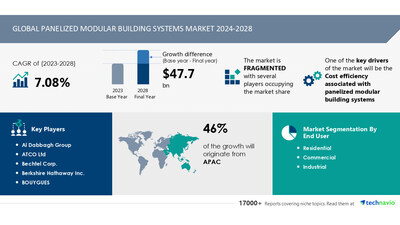NEW YORK, Oct. 25, 2024 /PRNewswire/ — Report on how AI is driving market transformation – The Global Panelized Modular Building Systems Market size is estimated to grow by USD 47.7 billion from 2024-2028, according to Technavio. The market is estimated to grow at a CAGR of 7.08% during the forecast period. Cost efficiency associated with panelized modular building systems is driving market growth, with a trend towards Increase in number of merger and acquisition among vendors. However, skepticism towards modular construction poses a challenge. Key market players include Al Dabbagh Group, ATCO Ltd, Bechtel Corp., Berkshire Hathaway Inc., BOUYGUES, ClarkWestern Dietrich Building Systems LLC, Dexterra Group, EPACK Polymers Pvt Ltd., Fleetwood Australia, GUERDON LLC, Hickory, HONOMOBO, Kwikspace Pty Ltd., Laing O Rourke, Lendlease Corp. Ltd., Method Homes, Modulaire Group, Palomar Modular Buildings., Portakabin Ltd., Pujol Group, Skanska AB, The Wells Companies, Vantem, Volumetric Building Companies, and Wernick Group.
AI-Powered Market Evolution Insights. Our comprehensive market report ready with the latest trends, growth opportunities, and strategic analysis- View your snapshot now
|
Forecast period |
2024-2028 |
|
Base Year |
2023 |
|
Historic Data |
2018 – 2022 |
|
Segment Covered |
End-user (Residential, Commercial, and Industrial), Material (Wood, Metal, Concrete, and Composite), and Geography (APAC, North America, Europe, South America, and Middle East and Africa) |
|
Region Covered |
APAC, North America, Europe, South America, and Middle East and Africa |
|
Key companies profiled |
Al Dabbagh Group, ATCO Ltd, Bechtel Corp., Berkshire Hathaway Inc., BOUYGUES, ClarkWestern Dietrich Building Systems LLC, Dexterra Group, EPACK Polymers Pvt Ltd., Fleetwood Australia, GUERDON LLC, Hickory, HONOMOBO, Kwikspace Pty Ltd., Laing O Rourke, Lendlease Corp. Ltd., Method Homes, Modulaire Group, Palomar Modular Buildings., Portakabin Ltd., Pujol Group, Skanska AB, The Wells Companies, Vantem, Volumetric Building Companies, and Wernick Group |
Key Market Trends Fueling Growth
The panelized modular building systems market has experienced significant growth in recent years, with an increase in mergers and acquisitions among vendors. This trend reflects a broader consolidation effort aimed at enhancing economies of scale, improving technological capabilities, and expanding market reach. Companies are merging or acquiring other firms to integrate innovative technologies, streamline operations, and diversify product offerings. For instance, in July 2024, Wells acquired Gate Precast, extending its offerings and increasing its US footprint. In May 2023, Vantem acquired Affinity Building Systems as part of its national expansion plan. These strategic partnerships enable companies to meet the growing demand for efficient, cost-effective, and sustainable building solutions while navigating regulatory environments and supply chain challenges. These mergers and acquisitions are reshaping the construction industry, driving the adoption of advanced modular construction techniques, and reinforcing the role of panelized systems in modern architecture and construction. The global panelized modular building systems market is expected to witness continued growth due to these trends.
The Panelized Modular Building Systems market is experiencing significant growth, particularly in the areas of energy-efficient structures and sustainable construction practices. Prefabricated homes built with Structural Insulated Panels (SIPs) are becoming increasingly popular for their energy savings and cost-effectiveness. This trend is visible in various sectors, from low-cost housing and public units to luxury apartments and high-rise buildings. General contractors and developers are embracing offsite construction, including prefabricated methods, for residential infrastructure projects. Modular factories are producing complete 3D parts for walls, roof panels, and floors, making construction faster and more efficient. Earthquake-prone areas and extreme climatic conditions are driving the demand for these systems, as they offer superior strength and insulation. The construction sector is adopting digital tools like mobile devices and social media to streamline processes and improve communication. Sustainable construction practices, such as timber frame, are gaining traction, contributing to better living standards and reducing the industry’s carbon footprint. The market is also exploring the use of digital cash and omnichannel platforms to facilitate transactions and enhance customer experience.
Insights on how AI is driving innovation, efficiency, and market growth- Request Sample!
Market Challenges
- Modular construction, using panelized systems, is a newer approach to building compared to traditional methods. Skepticism towards this method is a significant challenge, as some industry professionals and stakeholders remain hesitant due to perceived issues with quality control, durability, and long-term performance. Established construction companies may be reluctant to adopt new technologies or shift their business models. Overcoming these barriers requires demonstrating proven success, addressing quality concerns through rigorous standards, and educating stakeholders about the benefits and advancements in modular construction. Despite advantages like reduced construction time and cost efficiency, widespread acceptance and integration of panelized modular building systems may be hindered by these misconceptions.
- The Panelized Modular Building Systems market is experiencing significant growth due to the increasing demand for efficient and sustainable construction solutions. Contractors and developers are turning to modular factories for industrial, residential, and commercial projects. However, challenges persist in this sector. One challenge is the adoption of new technologies such as mobile devices and social media for sales and marketing. Another is the integration of digital cash and omnichannel platforms for transactions. Timber frame and structural insulated panels are popular choices for energy-efficient structures, but building in earthquake-prone areas and extreme climatic conditions requires additional considerations. Walls, roof panels, and floors made of complete 3D parts ensure faster construction times and lower costs for low-cost housing, public housing units, luxury apartments, and high-rise buildings. Prefabricated homes and prefabricated construction practices are key trends in residential infrastructure. Sustainable construction practices and offsite construction are also gaining popularity in the construction sector. General contractors and modular factories must collaborate to address these challenges and meet the evolving needs of the market. By embracing innovation and adopting new technologies, the panelized modular building systems industry can continue to thrive and provide affordable, efficient, and sustainable solutions for all types of projects.
Insights into how AI is reshaping industries and driving growth- Download a Sample Report
Segment Overview
This panelized modular building systems market report extensively covers market segmentation by
- End-user
- 1.1 Residential
- 1.2 Commercial
- 1.3 Industrial
- Material
- 2.1 Wood
- 2.2 Metal
- 2.3 Concrete
- 2.4 Composite
- Geography
- 3.1 APAC
- 3.2 North America
- 3.3 Europe
- 3.4 South America
- 3.5 Middle East and Africa
1.1 Residential- The panelized modular building systems market is experiencing notable growth due to the increasing popularity of modular housing. This construction method offers a cost-effective solution for housing needs, with streamlined fabrication processes reducing labor costs, material waste, and construction time. In March 2024, Magicrete, an India-based manufacturer, completed a 1008-unit mass housing project using their 3D modular precast construction system. This project achieved cost parity with traditional methods while cutting construction time by up to 40%, showcasing the potential of precast concrete technology in India. Modular construction ensures consistent quality through controlled factory environments and standardized processes. Innovations in technology and design have expanded options for modern, sustainable, and adaptable homes, attracting consumers seeking affordable and quickly deployable housing solutions. The residential segment’s growth and the global panelized modular building systems market expansion are expected to continue, driven by the rising demand for affordable, efficient, and innovative housing solutions.
Download complimentary Sample Report to gain insights into AI’s impact on market dynamics, emerging trends, and future opportunities- including forecast (2024-2028) and historic data (2018 – 2022)
Research Analysis
Panelized modular building systems refer to a construction method where buildings are manufactured offsite in modular sections, including walls, roof panels, and floors, made of structural insulated panels or other materials like concrete or timber frame. These energy-efficient structures offer numerous benefits, including reduced construction time, lower labor costs, and improved quality control. The market for these systems caters to various sectors, including low-cost housing, public housing units, luxury apartments, and high-rise buildings. The construction sector, residential infrastructure, and general contractors and developers are key consumers. Sustainable construction practices and offsite prefabricated construction are driving the growth of this market. Modular factories use advanced technologies like cloud computing strategies to optimize production processes and improve efficiency. The banking market and mobile devices facilitate financing and design processes. Complete 3D parts ensure precision and accuracy in manufacturing.
Market Research Overview
The Panelized Modular Building Systems market encompasses energy-efficient structures made from prefabricated components, including structural insulated panels (SIPs). These systems are gaining popularity in various sectors, from low-cost housing and public housing units to luxury apartments and high-rise buildings. The construction sector is embracing sustainable practices, leading to an increase in offsite and prefabricated construction. Residential infrastructure, in particular, is benefiting from these advancements. Modular factories produce complete 3D parts, such as walls, roof panels, and floors, which are transported to the construction site for assembly. This method offers several advantages, including reduced construction time, lower costs, and improved living standards. Panelized systems are ideal for earthquake-prone areas and extreme climatic conditions. The market is also influenced by trends such as digital cash, omnichannel, mobile devices, and social media. Timber frame and industrial applications are other growing sectors within the market.
Table of Contents:
1 Executive Summary
2 Market Landscape
3 Market Sizing
4 Historic Market Size
5 Five Forces Analysis
6 Market Segmentation
- End-user
- Residential
- Commercial
- Industrial
- Material
- Wood
- Metal
- Concrete
- Composite
- Geography
- APAC
- North America
- Europe
- South America
- Middle East And Africa
7 Customer Landscape
8 Geographic Landscape
9 Drivers, Challenges, and Trends
10 Company Landscape
11 Company Analysis
12 Appendix
About Technavio
Technavio is a leading global technology research and advisory company. Their research and analysis focuses on emerging market trends and provides actionable insights to help businesses identify market opportunities and develop effective strategies to optimize their market positions.
With over 500 specialized analysts, Technavio’s report library consists of more than 17,000 reports and counting, covering 800 technologies, spanning across 50 countries. Their client base consists of enterprises of all sizes, including more than 100 Fortune 500 companies. This growing client base relies on Technavio’s comprehensive coverage, extensive research, and actionable market insights to identify opportunities in existing and potential markets and assess their competitive positions within changing market scenarios.
Contacts
Technavio Research
Jesse Maida
Media & Marketing Executive
US: +1 844 364 1100
UK: +44 203 893 3200
Email: [email protected]
Website: www.technavio.com/
![]() View original content to download multimedia:https://www.prnewswire.com/news-releases/panelized-modular-building-systems-market-to-grow-by-usd-47-7-billion-from-2024-2028–driven-by-cost-efficiency-and-ai-powered-market-evolution—technavio-302286515.html
View original content to download multimedia:https://www.prnewswire.com/news-releases/panelized-modular-building-systems-market-to-grow-by-usd-47-7-billion-from-2024-2028–driven-by-cost-efficiency-and-ai-powered-market-evolution—technavio-302286515.html
SOURCE Technavio

Featured Image: Deposit Photos @ Stockasso

















